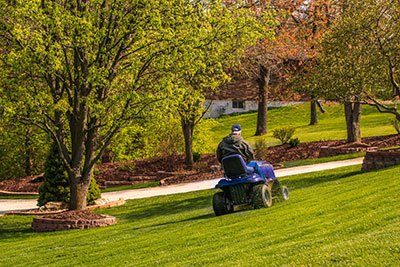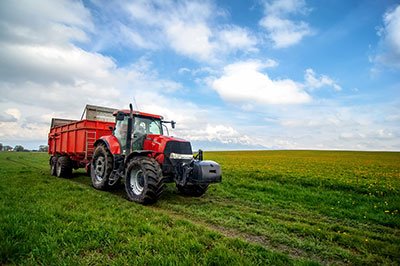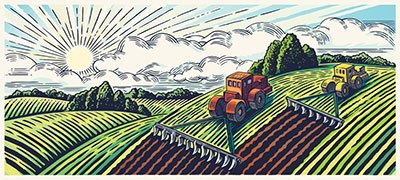If you own a tractor, it’s important to always practice safe driving when tackling even the slightest inclines or declines. Tractors are powerful machines and should be treated with caution, particularly on hills where extra security measures need to be taken.
In this post, we provide our top safety tips for approaching any hilly terrain in a tractor.
Take away key points:
- Rollovers are a major source of injuries and death in farmers
- Half seconds are enough to damage the traction and jeopardize yourself on hills
- Follow the steps below to ensure the best standards. If you notice some incorrect parts, ensure they are replaced immediately to avoid accidents
Table of Contents
- Avoiding tractor accidents to keep you safe
- FAQs
- What is the best way to drive on hills in a tractor?
- What is the maximum slope for tractor operation?
- What tractor is best for hills?
- When is it safe to pass a tractor trailer near the crest of a hill?
- Which type of tractor trailer has the greatest chance of a crack-the-whip rollover?
- How should you turn safely on slopes in a tractor?
- Conclusion
Avoiding tractor accidents to keep you safe
To eliminate the slightest risk of tractor falls, especially on bumpy terrains and hills, you must take proper precautions.
But, you must know the exact procedure, and ensure the best security standards for optimal tractor operations.
Tractor overturns: The leading cause of injuries and death in farmers

Tractor overturns can be dangerous and even deadly. A tractor overrun occurs when the tractor is moving faster than its engine can handle, causing it to lose control and overturn. This can happen when the tractor is going downhill or on a slippery surface, or if the driver takes a sharp turn too quickly. It can also occur if the driver fails to engage the brakes properly, or if the brakes are faulty.
In addition to being potentially fatal for the driver, tractor rear overturns and tractor rollovers can cause serious damage to property and crops. The force of an overturning tractor can cause it to crush anything in its path, including fences, buildings, and trees. It can also damage crops by uprooting them or crushing them under their weight.
To prevent tractor overruns, drivers should always use caution when driving on slopes or slippery surfaces. They should also make sure their brakes are working properly before starting their journey and check that they are engaging correctly during operation. Additionally, drivers should never take sharp turns at high speeds as this increases the risk of an overturn.
Safe operating procedures to prevent tractor overturns

There are various safety precautions and safety devices to use and ensure the proper operating techniques when driving uphill side, or on a slippery slope to avoid side overturns, rear overturns, side rollovers, and similar tractor turns. To ensure your tractor stability, you must:
1. Wear your seat belt properly
Ensuring your safety while operating a tractor is essential. Fastening the seat belt and keeping the roll bar in its upright position can help increase your chances of surviving an overturn on steep slopes to better than 99%. Without these two devices, the risk of injury or death increases significantly on descending hills.
In addition, ensure your ROPS system – Rollover Protective Structure is always turned on properly, to keep both the tractor and tractor operator safe and stable, preventing tractor rollovers.
The Roll-over protection system is always at its maximum performance, especially on sloping ground. The Roll-over protection system will prevent you from being ejected from the cabin and proper position on the sloping terrain.
In addition, the Roll-over protection system also ensures the seat belt is properly configured and you can work safely regardless of the tractor’s weight. It will prevent overturns and provide you with proper operation and tractor stability regardless of the steep hills and sloping ground.
2. Never have your tractor equipped more than you should
To ensure a safe and stable ride, it is important to ballast your tractor properly. This can be done by adding non-corrosive fluid in the tires or weights on the tractor.
Tire fluid is generally the most effective option, but if more weight is needed you can add weights to both the tires and the front of the tractor. Aim for an even 50/50 front-to-back weight distribution with as much weight low to the ground as possible.
In addition, do not attach more heavy rear-mounted equipment when going uphills, as the tractor begins falling back. The tractor lifts its front part, falling backward, and the tractor rolls back, causing injuries and even death. The rear wheels will not have enough speed and strength to push tractors forward. So pay attention to keeping the tractors equally balanced to ensure no rear or side rollovers on sloping ground and up position.
Do not pull loads and drive forward since the tractor makes an unbalanced position, and pulling rear-mounted equipment can also cause your four-wheel drive to rear overturns. Even if your roll over prevention is on, you can still get hurt, so make your protective zone and do not attach more than you should.
3. Use your front-end loader properly
A front-end loader is often misused, as you stretch its lifting capacity and incorrect uses. The correct balance of the front-end loader-equipped tractors is necessary for stable lifting. So, your front-end loader must be properly positioned for a better center of gravity.
Ensure the front-end loader is lower to the ground to ensure more stability of tractors on hills. This will not pull the rear wheels into an awkward position, and you can ensure maximum roll over prevention.
4. Widen your tractor tires and wheels
Increasing the width of your tractor’s tires and wheels can greatly enhance its stability and improve traction. Many tractors have an offset solid rim dish, allowing the user to widen the footprint simply by swapping tires from one side to the other.
If your four-wheel drive tractor has a bolted-on center section, you may have multiple options for tread width: consult your tractor operator’s manual for details.
5. Maintain your tractor regularly
To ensure your tractor runs optimally and safely, it is important to perform regular maintenance. You can look for the tractor owner manual to see what maintenance tips you can perform.
Check the brakes are functioning properly, make sure the 4WD engages (if equipped), and ensure the tires have adequate tread. The owner’s manuals are the best source for optimal use and maintenance.
Extra tips for tractor operation precautions

Here are some of the additional safety standards to ensure the maximum security of tractor operators when on slippery ground and steep slopes.
1. Going slowly on slopes
When operating your tractor on a slope, it is important to take extra caution and maintain a lower speed and steady speed. Excessive tractor speed can easily lead to a rollover, which can be dangerous – so be sure to keep your speed low!
2. Know your terrain
Always be aware of the terrain you are working in. Tractors tend to tip over on sloping hills and large rocks can increase the risk of injuries and death. So, try to avoid them.
Make sure to fill in any large holes, and remove any obstructions before operating your tractor in the fields for maximum tractor safety. Also, turn downhill, not uphill when your overall stability becomes uncertain on ramps and slopes.
3. Keep your tractor load low
When using a front-end loader, it is important to keep the load as low as possible. This ensures that your center of gravity is maintained, and increases your stability when operating on slopes.
Also, ensure that the centrifugal force (the force that pushes out on a tractor when making a turn) is optimal. Too much centrifugal force and excessive speed can cause damage to brake pedals, and you cannot maneuver fast to prevent accidents.
4. Back up and down hills
When driving over hills, it is much safer to back up and down them rather than drive across. Although this may be more time-consuming when brush hogging, the added security this method offers is well worth the extra effort. Make your stops, headland turns, and similar changes on more level ground to ensure better operations of your tractors.
5. Ensure your security standards
Look after yourself when working on the farm. Fatigue, distractions, and impairment can all cause serious accidents – especially when compounded with one another. Urban work and stress can leave you feeling tired, potentially leading to a dangerous combination if combined with alcohol.
Of course, never bring extra riders onto your tractors. If you must take one with you, consult your operator’s manual to see if tractors can handle the extra weight. Never bring any children as well, as you can jeopardize their lives too. For each extra rider, you should check the owner’s manual first.
6. Pay attention to weather conditions
Take weather into account when conducting farm operations. Driving in wet or windy conditions can result in rollovers, and particularly when dealing with round bales in the cold season you may not have much of a choice.
But, if you do, it’s best to stay safe and avoid any potential accidents. Be extra careful around newly mowed grass as that can cause a slippery situation that is difficult to control.
FAQs
What is the best way to drive on hills in a tractor?
The best way is to keep your tractors in gears and step on brakes to go slowly.
What is the maximum slope for tractor operation?
The slope should be 35% or less for logged tractors. Find more information HERE.
What tractor is best for hills?
The two best models include the John Deere X739 lineup or Husqvarna TS 354XD (54”) 24HP Kawasaki Garden Tractor.
When is it safe to pass a tractor trailer near the crest of a hill?

It’s safe to pass it when you can see the entire road ahead before passing. Ensure there is enough space between your vehicle and the tractor trailer so that you can safely pass.
Which type of tractor trailer has the greatest chance of a crack-the-whip rollover?
Tractor trailers that are carrying a high center of gravity load, such as livestock or liquid tanks, have the greatest chance of a crack-the-whip rollover.
How should you turn safely on slopes in a tractor?
Follow these steps:
– Don’t start or stop on slopes.
– Don’t make any sudden stops, headland turns, or direction changes on steep slopes.
– Know the slope rating of your tractor and do not exceed it when driving across steep slopes.
– Scope out potential hazards before driving down a slope and limit attachments that could increase the risk of tipping over.
– Know your model’s limits and only go up to one foot of incline for every four feet of horizontal width.
Conclusion
There are multiple security standards to take and ensure you are safe and sound on the hills. Learn all steps to keep your machine optimal and safe.

